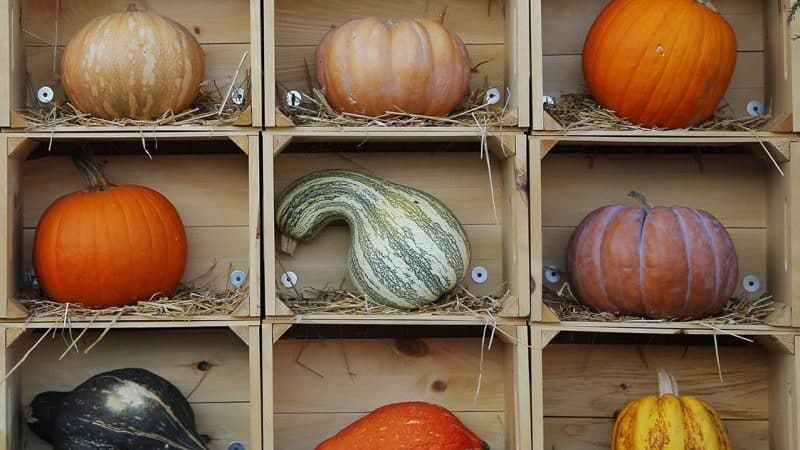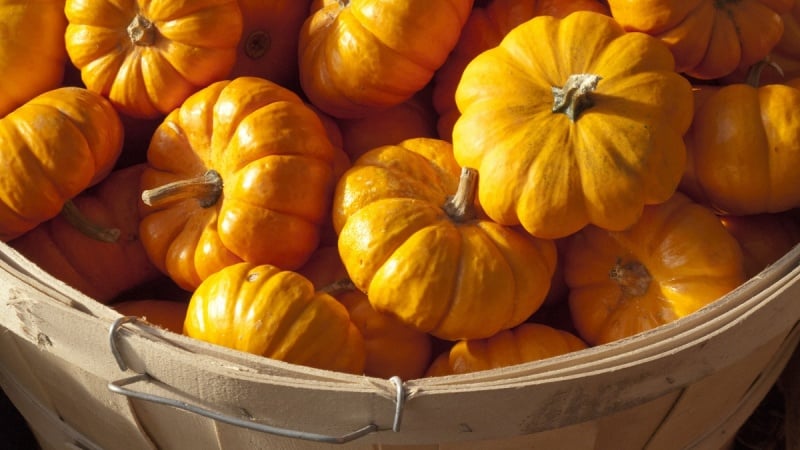How to store pumpkin in the cellar for the winter: create favorable conditions to avoid spoilage of the vegetable
Pumpkin is a healthy and tasty product that adults and children love. The plant is easy to care for; even a beginner can cope with its cultivation. After harvesting a rich harvest, the problem of storing it becomes urgent.
From the article you will learn how to store a pumpkin in a cellar for the winter, how to prepare the room and the fruits themselves, and under what conditions the harvest will last until spring.
Is it possible to store pumpkin in the cellar?
Pumpkin is a universal product used for preparing first and second courses and desserts. The harvest collected from your own garden is especially tasty and healthy. But is it possible to preserve the fruits for a long time?
For this purpose, choose dry, cool and dark rooms. Owners of private houses use a cellar for storage; residents of megacities have to be content with balconies and basements.

Points for and against"
It’s good if the gardener has a cellar for storing vegetables. However, having a suitable room does not mean that you can put away the harvest and forget about it for a long time. Storage rules must be followed.
Despite the fact that pumpkin vegetables can be stored until spring, under unfavorable conditions they quickly deteriorate. To enjoy fresh vegetables in winter, you will need to work hard to prepare the room.
In addition to the cost of processing and disinfection, it is necessary to make good ventilation, and also take care of purchasing racks and shelves.
Optimal storage conditions
Most basements are suitable for long-term storage of crops. Violation of temperature indicators leads to loss of taste, freezing and spoilage of the pumpkin.
Requirements for the cellar

Optimal conditions for storing pumpkins are air temperature +5°C (+10°C for some varieties) and humidity - 70-75%. Keep in mind that the indicators differ at different heights relative to the floor: the lower, the colder. It is recommended to take temperature measurements at the lower level.
If the temperature there is 0...+2°C, the crop is transferred to shelves or racks.
In severe frosts, the pumpkin may freeze. In winter, it is necessary to monitor changes in temperature in the cellar. As soon as the mark drops below 0°C, the fruits are wrapped in straw, old fur coats or blankets.
Suitable varieties
Not all pumpkin varieties are suitable for long-term storage. Late-ripening fruits with strong skin and rich orange pulp will safely overwinter in the cellar.
Among these varieties:
- Vitamin;
- Zhdana;
- Pearl;
- Arbatskaya;
- Muscat;
- Gymnosperm;
- Interception;
- Vita;
- Butternut;
- Testi Delipe.
How to prepare pumpkin for storage in the cellar
For long term storage Only whole, unspoiled fruits are selected. If dark spots or other damage appears on the pumpkin, it is better to process it immediately.
Important! Pumpkins with moldy areas must be disposed of - simply cutting off the damage is not enough.
When harvesting, it is important for gardeners to leave a 10 cm long stalk on the fruit. Such pumpkins last longer. The tail is not torn off with bare hands, but a knife is used. If the stalk has been cut off completely, this opens access inside for bacteria and infections. The tail should be green and undamaged.
Strong and fully ripened pumpkins are sent to the cellar. Fruits that are too small or large are not suitable for home storage - it is better to process them or freeze them.
The collected fruits are cleaned of dirt with a dry towel. If the harvest took place in rainy weather, the pumpkins are completely dried in a dry, dark place before storing.
Preparing the premises

Preparing the cellar for harvest storage is an important event, without which it is impossible to ensure the safety of vegetables until winter. Work on the improvement of the premises begins a month before harvesting the fruits.
Stages of room preparation:
- Get rid of dampness and mold. The cellar is ventilated, the racks and shelves are treated and dried, and a ventilation system is installed.
- Disinfect from infections and parasites. In the fall, before planting vegetables, the room is treated with a sulfur bomb or lime.
- Clear away debris. The entire last year's harvest is taken out of the cellar. Vegetables are thrown away or processed. Cans of preserved food are left on the shelves.
- Prepare the racks. The shelves are lined with several layers of paper or straw.
Admissible neighborhood
Not all vegetables can be stored with pumpkin. It easily absorbs odors, which spoils its taste. The fruits can be stored with zucchini, eggplant and radishes. It is better not to intersect pumpkin with other crops.
Important! Apples and pears are not the best neighbors for pumpkins. Fruits emit ethylene, which reduces the shelf life of the fruit.
If the room is small and you need to store several types of vegetables, the crops are placed at different height levels.
Methods for storing pumpkin
When stored properly, pumpkin remains fresh and does not lose its taste.Fruits with traces of rot or an unpleasant odor are not suitable for consumption.
To keep the pumpkin fresh, it is better to store it whole. However, in city conditions, most owners prefer to use space sparingly, so they cut it into pieces.
Whole fruits
In order for the pumpkin to survive until spring, you need to arrange it correctly:
- Fruits are not stored on bare shelves - the racks are covered with straw or paper.
- The pumpkin should not touch the walls of the room. Due to temperature changes, condensation and mold form on them.
- The fruits are placed with the stalks facing up. You can see from the tail that the vegetable has begun to deteriorate.
- The pumpkin should not come into contact with its “neighbors”. If one fruit rots, the entire harvest will be spoiled.
- Vegetables should not be stored in a pyramid or piled on the floor.
- Check the stock status once a month or more often.
Regular visits to the cellar will allow you to notice problems in time. If condensation begins to form on the fruits, this is a sign of increased air humidity. The situation requires immediate action, otherwise the plaque will eventually turn into dark spots and the harvest will be spoiled.
To reduce humidity, the room is regularly ventilated. You can also put a bucket of quicklime in the cellar - it absorbs moisture well.
If there are no shelving in the cellar, the pumpkin is stored in boxes or boxes. It is important to fill the spaces between the vegetables with straw or newspaper so that their sides do not touch.
Cut into pieces
To save space, cut the pumpkin into pieces, freeze and place in the refrigerator. If stored properly, it will remain fresh for a year.

How to prepare pumpkin for freezing:
- Wash the vegetable and peel it.
- Remove pumpkin seeds.
- Cut into pieces.
- Place in portions into containers or plastic bags.
- Place the workpiece in the freezer.
Peculiarity. Frozen pumpkin is used to prepare various dishes, with the exception of juice.
Shelf life
The shelf life of pumpkin depends on the characteristics of the variety. Forage varieties last for several months, nutmeg varieties last for six months, and the most durable table varieties last for more than 6 months.
You should not exceed the permissible storage period, even if the fruit looks intact and without damage.
Tips and tricks
To preserve your harvest without loss, follow expert advice:
- To disinfect the cellar, in addition to lime, use copper sulfate and a 2% solution of table salt.
- After using sulfur bombs, the cellar is ventilated for at least 2 days.
- To absorb moisture, boxes with dry sawdust and ash are placed in the room.
- As soon as the paper backing becomes damp, it is replaced.
- You can protect fruits from freezing by covering them with thick fabric.
- A common mistake gardeners make is picking unripe fruits, which causes them to spoil.
- Pumpkin has a natural protective layer, which, due to inexperience, the gardener can wash off. Before storing the fruit, just wipe it with a dry cloth.
Conclusion
Pumpkin is ideal for long-term storage. In the cellar or basement, the fruits will remain fresh until spring. If you prepare the room for planting the harvest, monitor temperature and humidity indicators, and also stack the fruits correctly, you can enjoy fresh pumpkin all year long.